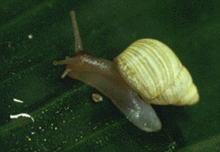This article needs additional citations for verification. (June 2024) |
| Partula | |
|---|---|

| |
| Partula radiolata | |
| Scientific classification | |
| Domain: | Eukaryota |
| Kingdom: | Animalia |
| Phylum: | Mollusca |
| Class: | Gastropoda |
| Order: | Stylommatophora |
| Infraorder: | Pupilloidei |
| Superfamily: | Pupilloidea |
| Family: | Partulidae |
| Genus: | Partula Férussac, 1821[1] |
| Synonyms | |
|
list of synonyms:
| |



Partula is a genus of air-breathing tropical land snails, terrestrial pulmonate gastropod mollusks in the family Partulidae.[2][3]
Many species of Partula are known under the general common names "Polynesian tree snail" and "Moorean viviparous tree snail".[4] Partulids are distributed across 5,000 sq mi (13,000 km2) of Pacific Ocean islands, from the Society Islands to New Guinea.[citation needed]
Once used as decorative items in Polynesian ceremonial wear and jewelry, these small snails (averaging about one-half to three-quarters of an inch in length) gained the attention of science when Dr. Henry Crampton (along with Yoshio Kondo) spent 50 years studying and cataloging partulids, detailing their remarkable array of morphological elements, ecological niches, and behavioral aspects that illustrate adaptive radiation.[5][6]
- ^ Férussac A. É. d'A. de (June 1821). Journ. de Physique 92: 460; 1821, H.N. g. et p. Moll., Tabl. Limaçons, 23.
- ^ Myers, P.; Espinosa, R.; Parr, C. S.; Jones, T.; Hammond, G. S. & Dewey, T. A. (2006). The Animal Diversity Web (online). Accessed at http://animaldiversity.org.
- ^ ITIS Standard Report Page: Partulidae
- ^ Searching for "Partula". In: IUCN 2010. IUCN Red List of Threatened Species. Version 2010.3. <www.iucnredlist.org>. Downloaded on 14 September 2010.
- ^ Jung, Younghun, Taehwan Lee, Burch J. B. & Diarmaid Ó Foighil. (2005) "Historical phylogeny of Tahitian Partula". Proc. Joint Conference - American Malacological Society and Western Society of Malacologists.
- ^ Gerlach, J. (2016) Icons of Evolution - Pacific island tree snails, family Partulidae. Phelsuma Press, Cambridge